Halderman J.D., Linder J. Automotive Fuel and Emissions Control Systems
Подождите немного. Документ загружается.

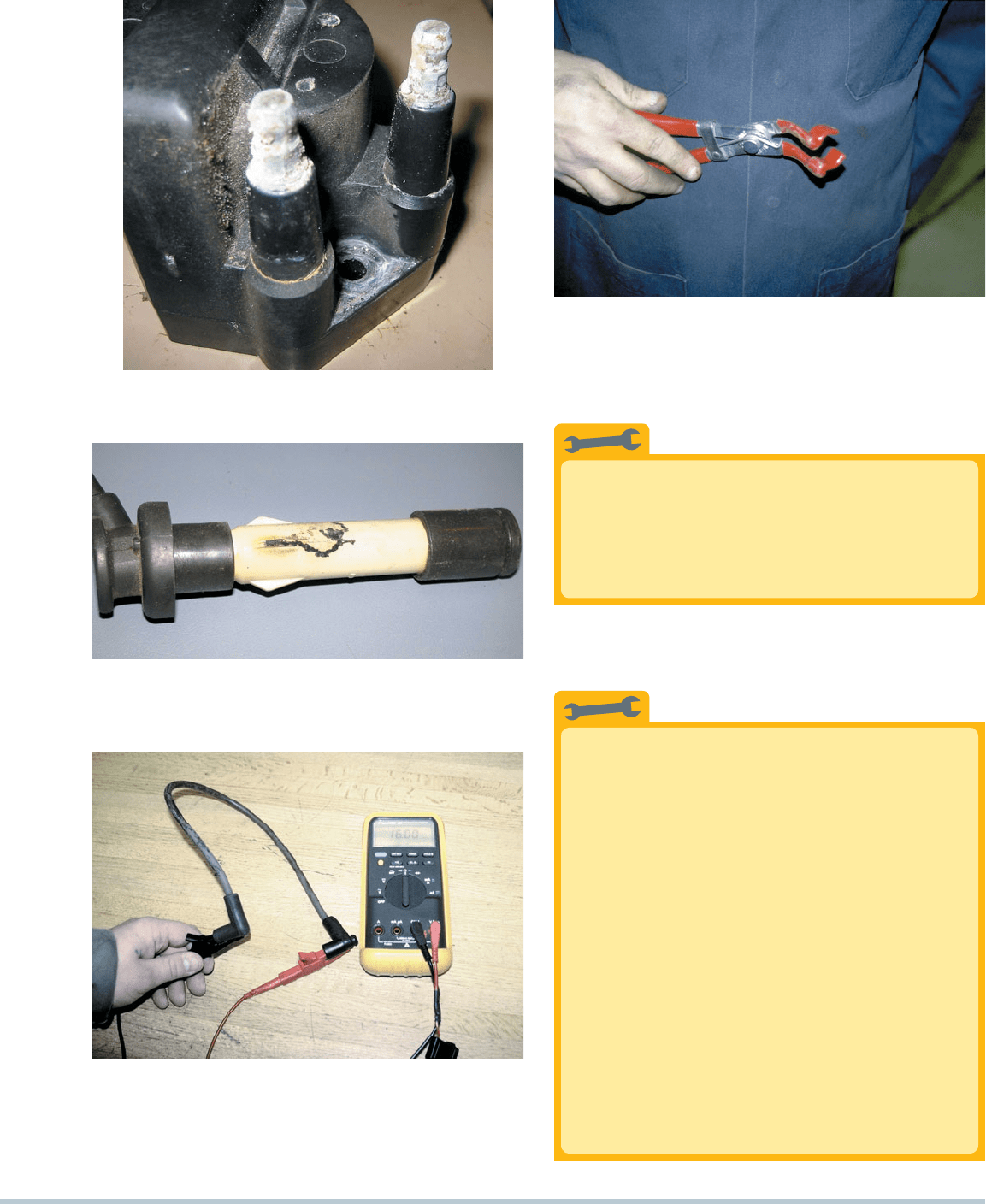
IGNITION SYSTEM OPERATION AND DIAGNOSIS 371
FIGURE 29–29 Corroded terminals on a waste-spark coil
can cause misfire diagnostic trouble codes to be set.
FIGURE 29–30 This spark plug boot on an overhead
camshaft engine has been arcing to the valve cover causing
amisfire to occur.
FIGURE 29–31 Measuring the resistance of a spark plug
wire with a multimeter set to the ohms position. The reading
of 16.03 kΩ (16,030 ohms) is okay because the wire is about
2feet long. Maximum allowable resistance for a spark plug
wire this long would be 20 kΩ (20,000 ohms).
FIGURE 29–32 This spark plug wire boot pliers is a handy
addition to any tool box.
Spark Plug Wire Pliers Are a Good Investment
Spark plug wires are often difficult to remove. Using
good-quality spark plug wire pliers, as shown in
FIGURE 29–32 , saves time and reduces the
chance of harming the wire during removal.
TECH TIP
Route the Wires Right!
High voltage is present through spark plug wires
when the engine is running. Surrounding the spark
plug wires is a magnetic field that can affect other
circuits or components of the vehicle. For exam-
ple, if a spark plug wire is routed too closely to
the signal wire from a mass airflow (MAF) sensor,
the induced signal from the ignition wire could
create a false MAF signal to the computer. The
computer, not able to detect that the signal was
false, would act on the MAF signal and command
the appropriate amount of fuel based on the false
MAF signal.
To prevent any problems associated with high-
voltage spark plug wires, be sure to route them using
all of the factory holding brackets and wiring combs.
SEE FIGURE 29–33 .
If the factory method is unknown, most factory
service information shows the correct routing.
TECH TIP
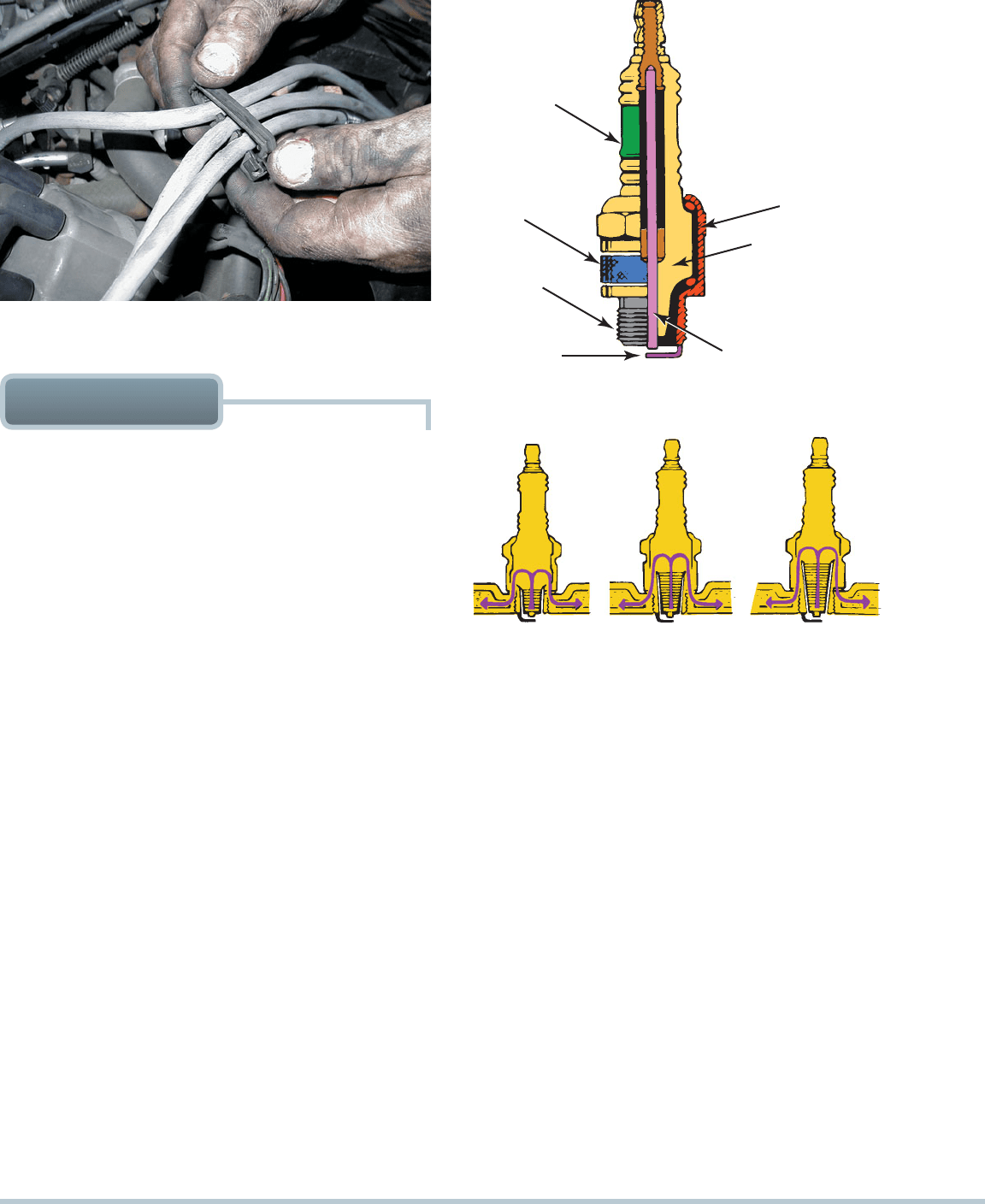
372 CHAPTER 29
in diameter. The small diameter reduces the voltage required to
jump the gap between the center and the side electrode, thereby
reducing possible misfires. The ground or side electrode is usu-
ally tipped with platinum to help reduce electrode gap wear.
Spark plugs should be inspected when an engine perfor-
mance problem occurs and should be replaced at specified in-
tervals to ensure proper ignition system performance:
Nonplatinum spark plugs have a service life of over
20,000 miles (32,000 km).
Platinum-tipped original equipment spark plugs have a
typical service life of 60,000 to 100,000 miles (100,000 to
160,000 km) or longer.
Used spark plugs should not be cleaned and reused un-
less absolutely necessary. The labor required to remove and
replace (R & R) spark plugs is the same whether the spark plugs
are replaced or cleaned. Although cleaning spark plugs often
restores proper engine operation, the service life of cleaned
spark plugs is definitely shorter than that of new spark plugs.
FIGURE 29–33 Always take the time to install spark plug
wires back into the original holding brackets (wiring combs).
CERAMIC
INSULATOR
METAL SHELL
INSULATION
CENTER
ELECTRODE
SIDE
ELECTRODE
THREADS
METAL
SHELL
FIGURE 29–34 Parts of a spark plug.
FAST
HEAT
TRANSFER
MEDIUM
HEAT
TRANSFER
SLOW
HEAT
TRANSFER
COLD PLUG
HOT PLUG
FIGURE 29–35 The heat range of a spark plug is determined
by distance the heat flows from the tip to the cylinder head.
SPARK PLUG CONSTRUCTION Spark plugs are manu-
factured from ceramic insulators inside a steel shell. The threads
of the shell are rolled and a seat is formed to create a gastight
seal with the cylinder head.
SEE FIGURE 29–34 .
The physical differences in spark plugs include the following:
Reach. This is the length of the threaded part of the plug.
Heat range. This refers to how rapidly the heat created
at the tip is transferred to the cylinder head. A spark plug
with a long ceramic insulator path will run hotter at the tip
than one that has a shorter path because the heat must
travel farther.
SEE FIGURE 29–35 .
Type of seat. Some spark plugs use a gasket, and others
rely on a tapered seat to seal.
RESISTOR SPARK PLUGS Most spark plugs include a
resistor in the center electrode, which helps to reduce electro-
magnetic noise or radiation from the ignition system. The closer
the resistor is to the actual spark or arc, the more effective it
becomes. The value of the resistor is usually between 2,500
and 7,500 ohms.
PLATINUM SPARK PLUGS Platinum spark plugs have
a small amount of the precious metal platinum included on the
end of the center electrode as well as on the ground or side
electrode. Platinum is a gray-white metal that does not react
with oxygen and, therefore, will not erode away as can occur
with conventional nickel alloy spark plug electrodes. Platinum is
also used as a catalyst in catalytic converters, where it is able to
start a chemical reaction without itself being consumed.
IRIDIUM SPARK PLUGS Iridium is a white precious metal
and is the most corrosion-resistant metal known. Most iridium
spark plugs use a small amount of iridium welded onto the tip
of a small center electrode, 0.0015 to 0.002 inch (0.4 to 0.6 mm)
SPARK PLUGS
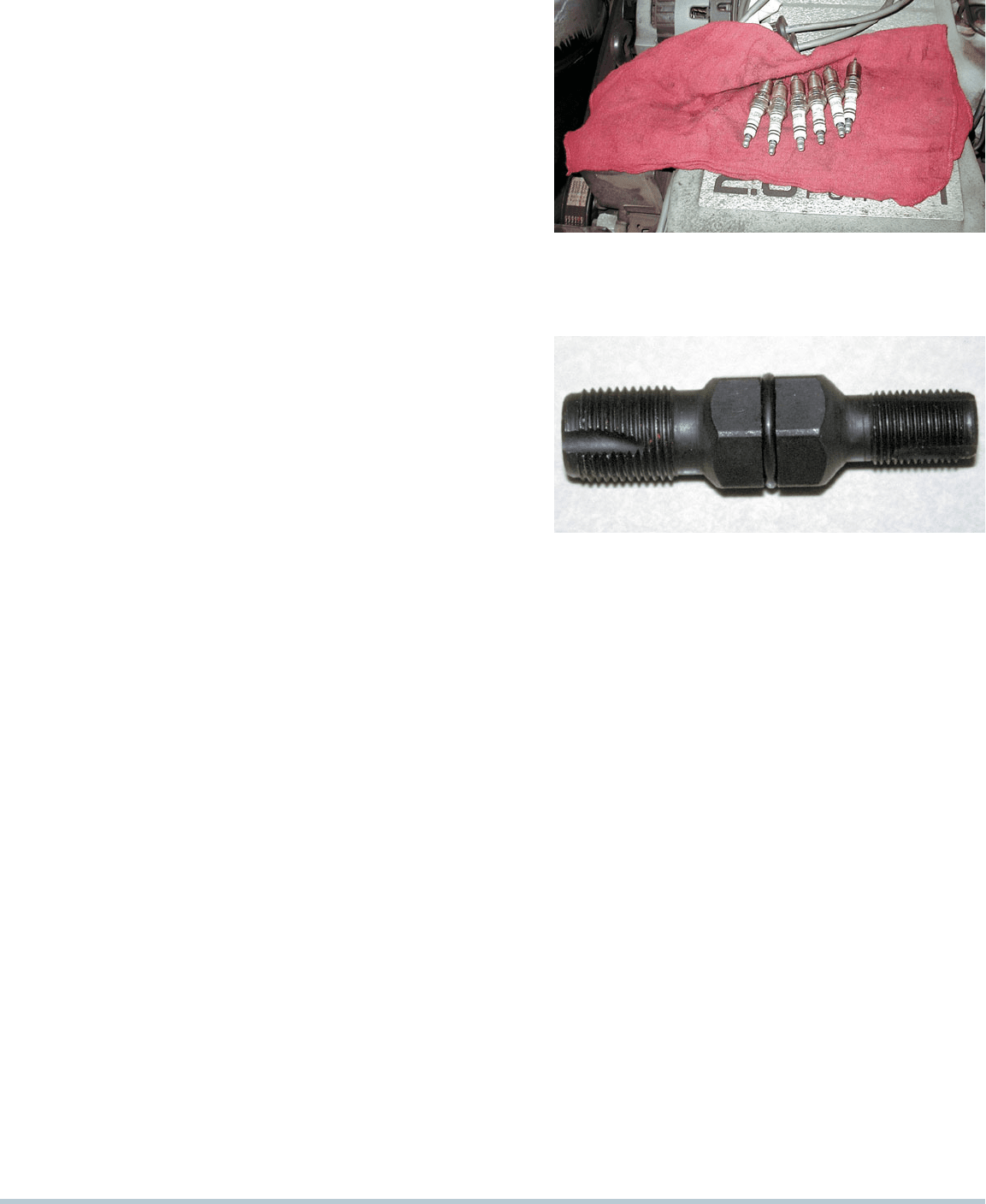
IGNITION SYSTEM OPERATION AND DIAGNOSIS 373
NOTE: Platinum-tipped spark plugs should not be re-
gapped on one that has been used in an engine be-
fore. The engine heat makes the platinum brittle, and
the center electrode can be easily broken if regapping
the plug is attempted. Using a gapping tool can break
the platinum after it has been used in an engine. Check
service information regarding the recommended type of
spark plugs and the specified service procedures.
SPARK PLUG SERVICE When replacing spark plugs, per-
form the following steps:
STEP 1 Check service information. Check for the exact
spark plug to use and the specified instructions and/
or technical service bulletins that affect the number of
plug to be used or a revised replacement procedure.
STEP 2 Allow the engine to cool before removing spark
plugs. This is true especially on engines with alumi-
num cylinder heads.
STEP 3 Use compressed air or a brush to remove dirt from
around the spark plug before removal. This step
helps prevent dirt from getting into the cylinder of an
engine while removing a spark.
STEP 4 Check the spark plug gap and correct as needed.
Be careful not to damage the tip on the center electrode
if adjusting a platinum or iridium type of spark plug.
STEP 5 Install the spark plugs by hand. After tightening by
hand, use a torque wrench and tighten the spark plugs
to factory specifications.
SEE FIGURES 29–36 AND
29–37 .
Spark plugs are the windows to the inside of the combustion
chamber. A thorough visual inspection of the spark plugs often
can lead to the root cause of an engine performance problem.
Two indications on spark plugs and their possible root causes
in engine performance include the following:
1. Carbon fouling. If the spark plug(s) has dry black carbon
(soot), the usual causes include the following:
Excessive idling
Overly rich air-fuel mixture due to a fuel system fault
Weak ignition system output
2. Oil fouling. If the spark plug has wet, oily deposits with lit-
tle electrode wear, oil may be getting into the combustion
chamber from the following:
Worn or broken piston rings
Worn valve guides
Defective or missing valve stem seals
When removing spark plugs, place them in order so that
they can be inspected to check for engine problems that might af-
fect one or more cylinders. All spark plugs should be in the same
condition, and the color of the center insulator should be light tan
or gray. If all the spark plugs are black or dark, the engine should
be checked for conditions that could cause an overly rich air-fuel
mixture or possible oil burning. If only one or a few spark plugs
are black, check those cylinders for proper firing (possible defec-
tive spark plug wire) or an engine condition affecting only those
particular cylinders.
SEE FIGURES 29–38 THROUGH 29–41 .
FIGURE 29–36 When removing spark plugs, it is wise to
arrange them in the order by the cylinder they were removed
from so that they can be compared and any problem can be
identified with a particular cylinder.
FIGURE 29–37 A spark plug thread chaser is a low-cost tool
that hopefully will not be used often but is necessary to use to
clean the threads before new spark plugs are installed.
If all spark plugs are white, check for possible overad-
vanced ignition timing or a vacuum leak causing a lean air-fuel
mixture. If only one or a few spark plugs are white, check for a
vacuum leak or injector fault affecting the air-fuel mixture only
to those particular cylinders.
NOTE: The engine computer “senses” rich or lean air-
fuel ratios by means of input from the oxygen sensor(s).
If one cylinder is lean, the PCM may make all other cyl-
inders richer to compensate.
Inspect all spark plugs for wear by first checking the condi-
tion of the center electrode. As a spark plug wears, the center
electrode becomes rounded. If the center electrode is rounded,
higher ignition system voltage is required to fire the spark plug.
When installing spark plugs, always use the correct tight-
ening torque to ensure proper heat transfer from the spark plug
shell to the cylinder head.
SEE CHART 29–1 .
NOTE: General Motors does not recommend the use of
antiseize compound on the threads of spark plugs be-
ing installed in an aluminum cylinder head because the
spark plug will be overtightened. This excessive tighten-
ing torque places the threaded portion of the spark plug
too far into the combustion chamber, where carbon can
accumulate and result in the spark plugs being difficult
to remove. If antiseize compound is used on spark plug
threads, reduce the tightening torque by 40%. Always
follow the vehicle manufacturer’s recommendations.

374
FIGURE 29–38 A normally worn spark plug that uses a
tapered platinum-tipped center electrode.
FIGURE 29–39 A worn spark plug showing fuel and/or oil
deposits.
FIGURE 29–40 A spark plug from an engine that had a
blown head gasket. The white deposits could be from the
aluminum of the piston or from the additives in the coolant.
FIGURE 29–41 A platinum tipped spark plug that is fuel
soaked indicating a fault with the fuel system or the ignition
system causing the spark plug to not fire.

IGNITION SYSTEM OPERATION AND DIAGNOSIS 375
TDC MARK
TIMING
MARK ON
HARMONIC
BALANCER
FIGURE 29–42 Ignition timing marks are found on the
harmonic balancers on engines equipped with distributors
thatcan be adjusted for timing.
or slightly before TDC (BTDC). Ignition timing changes as me-
chanical wear occurs to the following:
Timing chain
Distributor gear
Camshaft drive gear
CHECKING IGNITION TIMING To be assured of the
proper ignition timing, follow exactly the timing procedure indi-
cated on the underhood vehicle emission control information
(VECI) decal.
SEE FIGURE 29–44 .
NOTE: The ignition timing for waste-spark and coil-on-
plug ignition systems cannot be adjusted.
CHART 29–1
Typical spark plug installation torque.
TORQUE WITH TORQUE WRENCH (LB-FT)
TORQUE WITHOUT TORQUE WRENCH
(TURNS AFTER SEATED)
SPARK PLUG TYPE CAST-IRON HEAD ALUMINUM HEAD CAST-IRON HEAD ALUMINUM HEAD
Gasket
14 mm
18 mm
26–30
32–38
18–22
28–34
1/4
1/4
1/4
1/4
Tapered seat
14 mm
18 mm
7–15
15–20
7–15
15–20
1/16 (snug)
1/16 (snug)
1/16 (snug)
1/16 (snug)
Two-Finger Trick
To help prevent overtightening a spark plug when
a torque wrench is not available, simply use two
fingers on the ratchet handle. Even the strongest
service technician cannot overtighten a spark plug
by using two fingers.
TECH TIP
PURPOSE Ignition timing refers to when the spark plug
fires in relation to piston position. The time when the spark
occurs depends on engine speed and, therefore, must be
advanced (spark plugs fire sooner) as the engine rotates faster.
The ignition in the cylinder takes a certain amount of time, usu-
ally 30 ms (30/1,000 of a second), and remains constant regard-
less of engine speed. Therefore, to maintain the most efficient
combustion, the ignition sequence has to occur sooner as
the engine speed increases. For maximum efficiency from the
expanding gases inside the combustion chamber, the burning
of the air-fuel mixture should end by about 10 degrees after top
dead center (ATDC). If the burning of the mixture is still occur-
ring after that point, the expanding gases do not exert much
force on the piston because the gases are “chasing” the piston
as it moves downward.
Therefore, to achieve the goal of having the air-fuel mix-
ture be completely burned by the time the piston reaches
10 degrees ATDC, the spark must be advanced (occur
sooner) as the engine speed increases. This timing advance
is determined and controlled by the PCM on most vehicles.
SEE FIGURES 29–42 AND 29–43 .
If the engine is equipped with a distributor, it may be pos-
sible to adjust the base or the initial timing. The initial timing is
usually set to fire the spark plug between zero degrees (TDC)
IGNITION TIMING
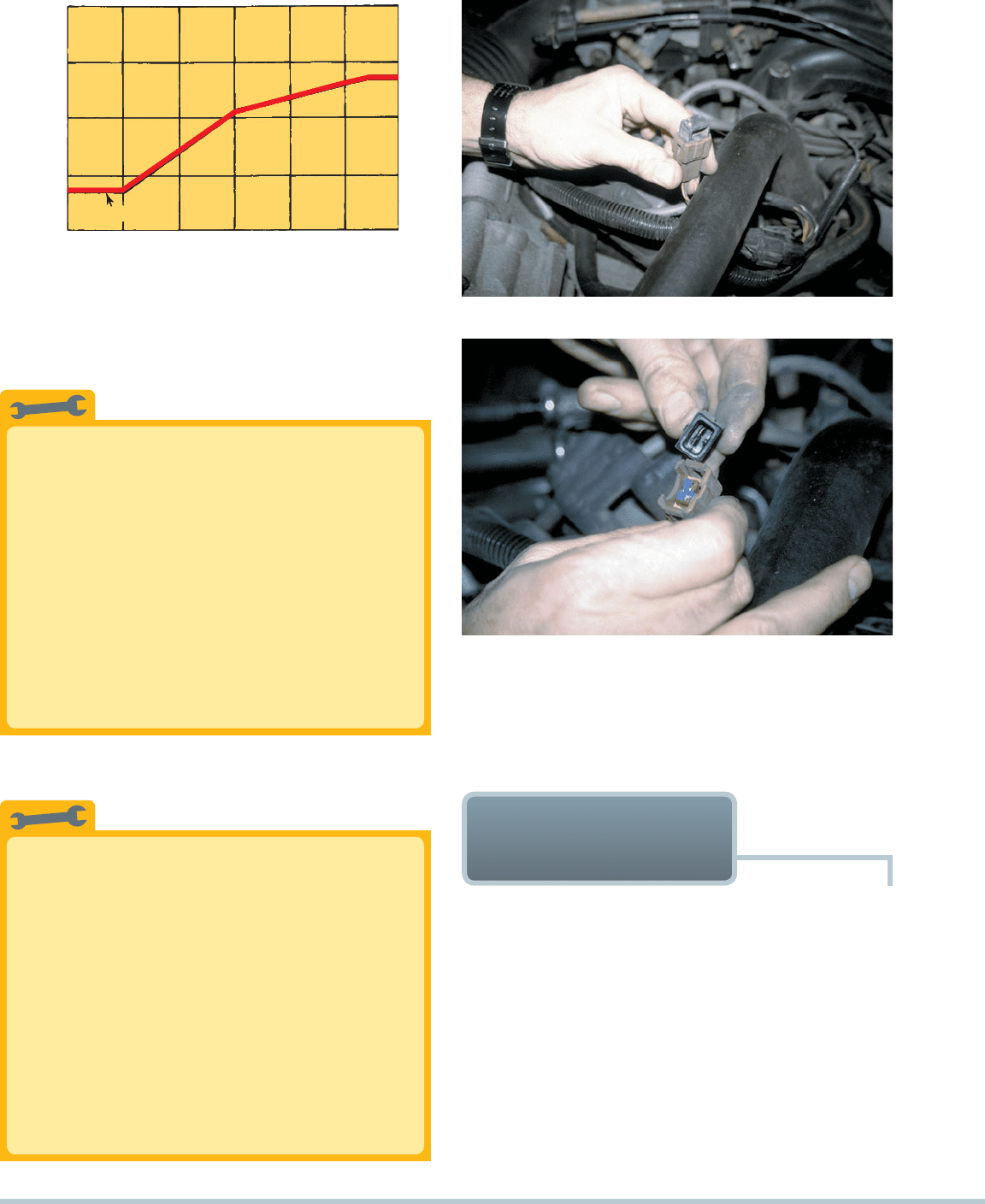
376 CHAPTER 29
1000
INITIAL TIMING
ADVANCE ANGLE BEFORE TDC
ENGINE SPEED
(
RPM
)
50004000
30002000
0
30°
0°
10°
20°
40°
FIGURE 29–43 The initial (base) timing is where the spark
plug fires at idle speed. The PCM then advances the timing
based primarily on engine speed.
(a)
(b)
FIGURE 29–44 (a) Typical SPOUT connector as used on many
Ford engines equipped with distributor ignition. (b) The connector
must be opened (disconnected) to check and/or adjust the
ignition timing. On DIS/EDIS systems, the connector is called
SPOUT/SAW (spark output/spark angle word).
Two Marks Are the Key to Success
When a distributor is removed from an engine, al-
ways mark where the rotor is pointing to ensure that
the distributor is reinstalled in the correct position.
Because of the helical cut on the distributor drive
gear, the rotor rotates as the distributor is being
removed from the engine. To help reinstall a distribu-
tor without any problems, simply make another mark
where the rotor is pointing just as the distributor
is lifted out of the engine. Then to reinstall, simply
line up the rotor to the second mark and lower the
distributor into the engine. The rotor should then line
up with the original mark as a double check.
TECH TIP
IGNITION SYSTEM
SYMPTOM GUIDE
Problem Possible Causes and/or Solutions
No spark out
of the coil
Open in the ignition switch circuit or theft
deterrent system fault
Defective ignition control module
Defective triggering device (magnetic
sensor, Hall-effect or optical sensor)
Weak spark
out of the coil
High-resistance coil wire or spark plug wire
Poor ground between the distributor or ig-
nition control module and the engine block
Engine misfire
Defective (open) spark plug wire
Worn or fouled spark plugs
Defective ignition control module (ICM)
Use a Water Spray Bottle to Check
the Secondary Ignition Circuit
To check for breaks in the insulation in the secondary
circuit perform the following steps:
STEP 1 Start the engine and allow to reach normal
operating temperature.
STEP 2 Using a water spray bottle set to mist,
spray the secondary ignition components
and listen for any change in operation.
STEP 3 If the engine operation is affected at all
there is a break in the secondary ignition
circuit insulation. Continue spraying to
pinpoint the exact location.
TECH TIP

IGNITION SYSTEM OPERATION AND DIAGNOSIS 377
5. A coil-on-plug ignition system uses an ignition coil for each
spark plug.
6. A thorough visual inspection should be performed on all
ignition components when diagnosing an engine perfor-
mance problem.
7. Platinum spark plugs should not be regapped after use in
an engine.
1. All inductive ignition systems supply battery voltage to the
positive side of the ignition coil and pulse the negative side of
the coil on and off to ground to create a high-voltage spark.
2. If an ignition system uses a distributor, it is a distributor
ignition system.
3. If an ignition system does not use a distributor, it is an
electronic ignition system.
4. A waste-spark ignition system fires two spark plugs at the
same time.
SUMMARY
5. Why should a spark tester be used to check for spark
rather than a standard spark plug?
6. How do you test a pickup coil for resistance and AC volt-
age output?
7. What harm can occur if the engine is cranked or run with
an open (defective) spark plug wire?
1. How can 12 volts from a battery be changed to 40,000 volts
for ignition?
2. How does a magnetic sensor work?
3. How does a Hall-effect sensor work?
4. How does a waste-spark ignition system work?
REVIEW QUESTIONS
7. The pulse generator ________ .
a. Fires the spark plug directly
b. Signals the ignition control module (ICM)
c. Signals the computer that fires the spark plug directly
d. Is used as a tachometer reference signal by the com-
puter and has no other function
8. Two technicians are discussing coil-on-plug ignition sys-
tems. Technician A says that they can be called coil-near-
plug or coil-by-plug ignition systems. Technician B says
that some can use ion sensing. Which technician is correct?
a. Technician A only
b. Technician B only
c. Both Technicians A and B
d. Neither Technician A nor B
9. A waste-spark-type ignition system fires ________ .
a. Two spark plugs at the same time
b. One spark plug with reverse polarity
c. One spark plug with straight polarity
d. All of the above
10. Technician A says that a defective crankshaft position
sensor can cause a no-spark condition. Technician B says
that a faulty ignition control module can cause a no-spark
condition. Which technician is correct?
a. Technician A only
b. Technician B only
c. Both Technicians A and B
d. Neither Technician A nor B
1. The primary (low-voltage) ignition system must be work-
ing correctly before any spark occurs from a coil. Which
component is not in the primary ignition circuit?
a. Spark plug wiring
b.
Ignition module (igniter)
c. Pickup coil (pulse generator)
d. Ignition switch
2. The ignition module has direct control over the firing of the
coil(s) of an ignition system. Which component(s) triggers
(controls) the module?
a. Pickup coil c. Crankshaft sensor
b. Computer d. All of the above
3. Distributor ignition systems can be triggered by a ________ .
a. Hall-effect sensor c. Spark sensor
b. Magnetic sensor d. Either a or b
4. Ignition coil primary resistance is usually ________ ohms.
a. 6,000 to 30,000 c. Less than 1 to 3
b. 150 to 1,500 d. Zero
5. Coil polarity is determined by the ________ .
a. Direction of rotation of the coil windings
b. Turn ratio
c. Direction of laminations
d. Saturation direction
6. A compression-sensing ignition system uses a ________
type of ignition.
a. Distributor c.
Waste-spark
b. Coil-on-plug d. All of the above
CHAPTER QUIZ
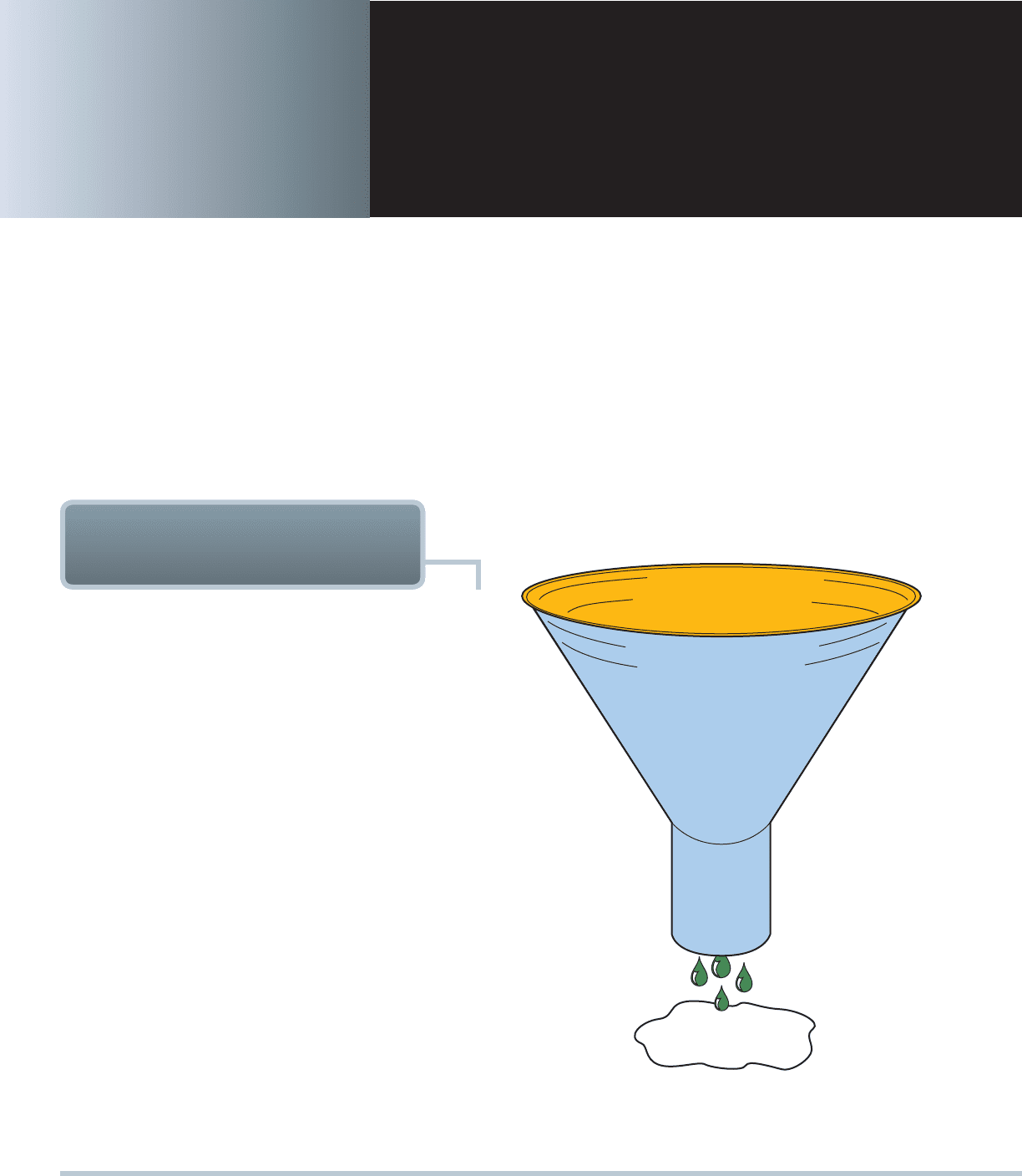
378 CHAPTER 30
chapter
SCAN TOOLS AND ENGINE
PERFORMANCE DIAGNOSIS
30
OBJECTIVES: After studying Chapter 30, the reader should be able to: • Prepare for the ASE computerized engine
controls diagnosis (A8) certification test content area “E.” • List the steps of the diagnostic process. • Describe the simple
preliminary tests that should be performed at the start of the diagnostic process. • List six items to check as part of a thorough
visual inspection. • Explain the troubleshooting procedures to follow if a diagnostic trouble code has been set. • Explain the
troubleshooting procedures to follow if no diagnostic trouble code has been set. • Discuss the type of scan tools that are used
to assess vehicle components. • Describe the methods that can be used to reprogram (reflash) a vehicle computer.
KEY TERMS: Data link connector (DLC) 383 • Drive cycle 395 • Flash code retrieval 386 • Key-on—engine off test
(KOEO) 387 • Key-on—engine running test (KOER) 387 • Paper test 381 • Pending code 382 • Self-test automatic
readout (STAR) 387 • Smoke machine 381 • Technical service bulletin (TSB) 382 • Trip 391
CUSTOMER
SATISFACTION
D
I
A
G
N
O
S
T
I
C
S
T
E
P
S
T
O
L
O
C
A
T
E
R
O
O
T
C
A
U
S
E
O
F
P
R
O
B
L
E
M
C
O
D
E
S
C
L
E
A
R
E
D
R
E
P
A
I
R
C
O
N
F
I
R
M
E
D
C
U
S
T
O
M
E
R
C
O
N
C
E
R
N
R
E
P
A
I
R
S
C
O
M
P
L
E
T
E
D
FIGURE 30–1 A funnel is one way to visualize the diagnostic
process. The purpose is to narrow the possible causes of a
concern until the root cause is determined and corrected.
THE EIGHT-STEP
DIAGNOSTIC PROCEDURE
It is important that all automotive service technicians know how
to diagnose and troubleshoot engine computer systems. The di-
agnostic process is a strategy that eliminates known-good com-
ponents or systems in order to find the root cause of automotive
engine performance problems. All vehicle manufacturers recom-
mend a diagnostic procedure, and the plan suggested in this
chapter combines most of the features of these plans plus addi-
tional steps developed over years of real-world problem solving.
Many different things can cause an engine performance
problem or concern. The service technician has to narrow the
possibilities to find the cause of the problem and correct it.
Afunnel is a way of visualizing a diagnostic procedure.
쎲 SEE
FIGURE 30–1. At the wide top are the symptoms of the problem;
the funnel narrows as possible causes are eliminated until the
root cause is found and corrected at the bottom of the funnel.
All problem diagnosis deals with symptoms that could be
the result of many different causes. The wide range of possible
solutions must be narrowed to the most likely, and these must
eventually be further narrowed to the actual cause. The follow-
ing section describes eight steps the service technician can take
to narrow the possibilities to one cause.
STEP 1 VERIFY THE PROBLEM (CONCERN) Before a
minute is spent on diagnosis, be certain that a problem exists.
If the problem cannot be verified, it cannot be solved or tested
to verify that the repair was complete.
쎲 SEE FIGURE 30–2.
M30_HALD2920_03_SE_CH30.indd 378 15/12/10 6:08 PM

SCAN TOOLS AND ENGINE PERFORMANCE DIAGNOSIS 379
are performed. A sample form that customers could fill out with
details of the problem is shown in
쎲 FIGURE 30–3.
NOTE: Because drivers differ, it is sometimes the best
policy to take the customer on the test drive to verify
the concern.
STEP 2 PERFORM A THOROUGH VISUAL INSPECTION
AND BASIC TESTS The visual inspection is the most
important aspect of diagnosis! Most experts agree that between
10% and 30% of all engine performance problems can be found
simply by performing a thorough visual inspection. The inspec-
tion should include the following:
쏋
Check for obvious problems (basics, basics, basics).
Fuel leaks
Vacuum hoses that are disconnected or split
Corroded connectors
Unusual noises, smoke, or smell
Check the air cleaner and air duct (squirrels and other
small animals can build nests or store dog food in
them)
쎲 SEE FIGURE 30–4.
쏋
Check everything that does and does not work. This
step involves turning things on and observing that every-
thing is working properly.
쏋
Look for evidence of previous repairs. Any time
work is performed on a vehicle, there is always a risk
that something will be disturbed, knocked off, or left
disconnected.
쏋
Check oil level and condition. Another area for visual
inspection is oil level and condition.
Oil level. Oil should be to the proper level.
The driver of the vehicle knows much about the vehicle
and how it is driven. Before diagnosis, always ask the following
questions:
쏋
Is the malfunction indicator light (check engine) on?
쏋
What was the temperature outside?
쏋
Was the engine warm or cold?
쏋
Was the problem during starting, acceleration, cruise,
or some other condition?
쏋
How far had the vehicle been driven?
쏋
Were any dash warning lights on? If so, which one(s)?
쏋
Has there been any service or repair work performed on
the vehicle lately?
NOTE: This last question is very important. Many engine
performance faults are often the result of something
being knocked loose or a hose falling off during repair
work. Knowing that the vehicle was just serviced before
the problem began may be an indicator as to where to
look for the solution to a problem.
After the nature and scope of the problem are determined,
the complaint should be verified before further diagnostic tests
CUSTOMER
SATISFACTION
S
T
E
P
1
–
V
E
R
I
F
Y
T
H
E
P
R
O
B
L
E
M
S
T
E
P
2
–
T
H
O
R
O
U
G
H
V
I
S
U
A
L
I
N
S
P
E
C
T
I
O
N
A
N
D
P
E
R
F
O
R
M
S
I
M
P
L
E
T
E
S
T
S
S
T
E
P
7
–
R
E
P
A
I
R
P
R
O
B
L
E
M
A
N
D
D
E
T
E
R
M
I
N
E
R
O
O
T
C
A
U
S
E
S
T
E
P
8
–
V
E
R
I
F
Y
T
H
E
R
E
P
A
I
R
A
N
D
C
L
E
A
R
A
N
Y
S
T
O
R
E
D
D
I
A
G
N
O
S
T
I
C
T
R
O
U
B
L
E
C
O
D
E
S
CUSTOMER CONCERN
(VEHICLE PROBLEM)
S
T
E
P
6
–
N
A
R
R
O
W
P
R
O
B
L
E
M
T
O
S
Y
S
T
E
M
O
R
C
Y
L
I
N
D
E
R
S
T
E
P
5
–
L
O
O
K
A
T
S
C
A
N
T
O
O
L
D
A
T
A
S
T
E
P
4
–
C
H
E
C
K
F
O
R
T
E
C
H
N
I
C
A
L
S
E
R
V
I
C
E
B
U
L
L
E
T
I
N
S
S
T
E
P
3
–
R
E
T
R
I
E
V
E
D
I
A
G
N
O
S
T
I
C
T
R
O
U
B
L
E
C
O
D
E
S
FIGURE 30–2 Step #1 is to verify the customer concern or
problem. If the problem cannot be verified, then the repair
cannot be verified.
“Original Equipment” Is Not a Four-Letter Word
To many service technicians, an original-equipment
part is considered to be only marginal, and to get the
really “good stuff” an aftermarket (renewal market) part
has to be purchased. However, many problems can
be traced to the use of an aftermarket part that has
failed early in its service life. Technicians who work
at dealerships usually begin their diagnosis with an
aftermarket part identified during a visual inspection. It
has been their experience that simply replacing the af-
termarket part with the factory original-equipment (OE)
part often solves the problem.
Original equipment parts are required to pass
quality and durability standards and tests at a level
not required of aftermarket parts. The technician
should be aware that the presence of a new part
does not necessarily mean that the part is good.
TECH TIP
M30_HALD2920_03_SE_CH30.indd 379 15/12/10 6:08 PM

380
FIGURE 30–3 A form that the customer should fill out if there is a driveablilty concern to help the service technician more
quickly find the root cause.
M30_HALD2920_03_SE_CH30.indd 380 15/12/10 6:08 PM
